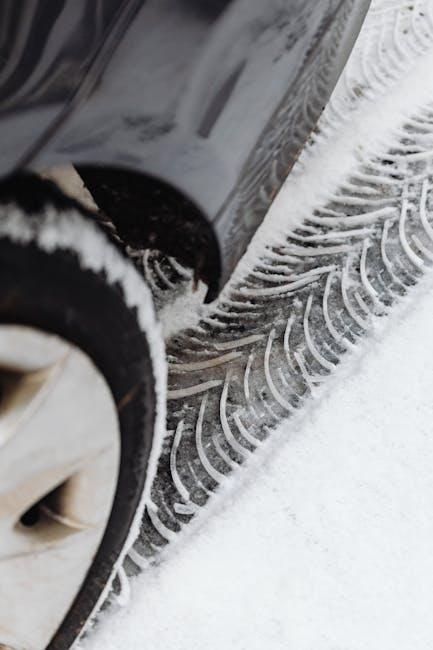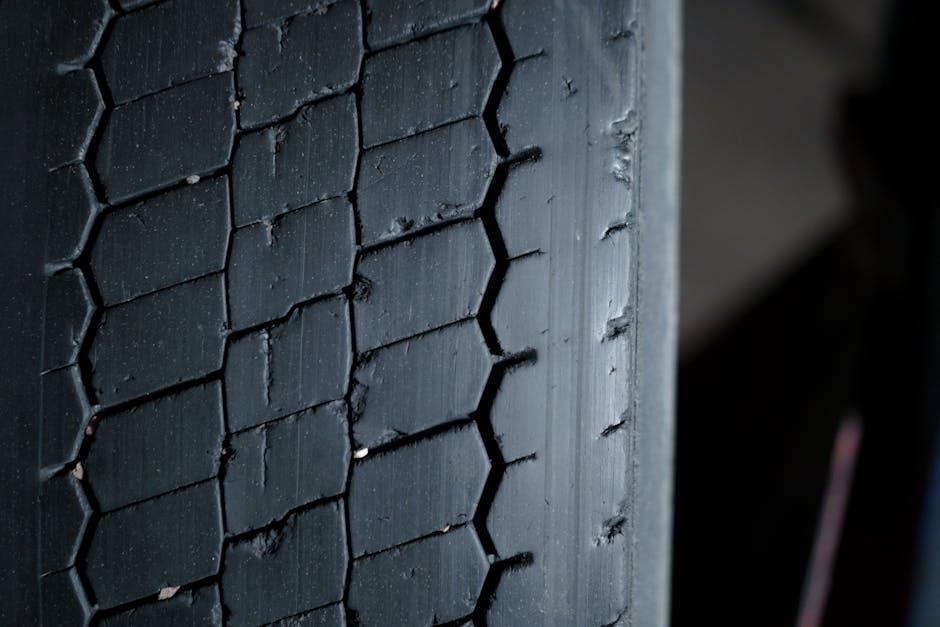Every journey you take, whether a quick trip to the store or a long-awaited road adventure, depends on one essential connection between your car and the road: your tires. Often overlooked, these rubber rings are your vehicle’s first line of defense against the unpredictable elements beneath your wheels. But how do you know when it’s time to say goodbye to them and welcome fresh ones on board? Understanding the subtle—and sometimes not so subtle—signs that indicate worn-out tires can mean the difference between smooth cruising and unexpected trouble. This article will guide you through the key indicators that it’s time to invest in new tires, keeping your rides safe, efficient, and comfortable.
Table of Contents
- When Tread Depth Tells a Story
- Uneven Wear Patterns and What They Mean
- The Age Factor No One Should Ignore
- Cracks, Bulges, and Other Visible Warnings
- Handling Challenges and Ride Comfort Clues
- Seasonal Considerations for Tire Replacement
- Q&A
- Wrapping Up

When Tread Depth Tells a Story
Tread depth isn’t just a measurement; it’s a narrative of your tire’s journey across countless roads and weather conditions. Each millimeter lost represents reduced grip and a growing risk on wet or icy surfaces. When your tires approach or fall below the legal minimum tread depth—usually 2/32 inch—it’s a clear signal that the rubber no longer holds the same promise of safety and performance. Getting familiar with the wear indicators on your tires is like reading the chapter endings of each mileage milestone, guiding you when it’s time to say goodbye to your current set and invest in new ones.
Understanding the tread’s story helps you anticipate changes long before you feel them on the road. Worn tires can lead to longer braking distances, increased hydroplaning chances, and uneven wear patterns that might hint at alignment or suspension problems. To keep your tires—and ultimately your vehicle—in prime condition, regularly check the tread depth using simple tools or the penny test. A tire with insufficient tread depth can be a silent hazard, but with a little attention, you’ll always be one step ahead in maintaining control and safety.
- Legal minimum tread: 2/32 inch
- Optimal tread for wet conditions: Above 4/32 inch
- Common wear indicators: Raised bars within tire grooves
| Tread Depth (inches) | Condition | Recommended Action |
|---|---|---|
| 6/32 or more | Good | Continue regular checks |
| 4/32 – 6/32 | Moderate | Prepare for replacement soon |
| Below 2/32 | Unsafe | Replace immediately |

Uneven Wear Patterns and What They Mean
When your tires show irregular wear, it’s a red flag signaling that something’s off with your vehicle’s alignment, suspension, or inflation. Inside wear often points to misalignment, making steering feel unstable, while outside wear may indicate underinflation. Meanwhile, patchy or cupped wear patterns can suggest suspension issues, causing a bumpy and noisy ride. Each pattern serves as a subtle SOS from your tires, nudging you to address the underlying problem before it accelerates.
Checking these patterns regularly can save you from costly repairs and extend tire life. Here’s a quick guide to what certain uneven wear signs often suggest:
- Feathered edges: Misaligned wheels or improper toe settings
- Bald spots or cupping: Worn suspension components
- Center wear: Overinflated tires
- Edge wear: Underinflated tires
| Wear Pattern | Possible Cause | Suggested Action |
|---|---|---|
| Inside edge wear | Toe misalignment | Wheel alignment check |
| Cupped tread | Suspension damage | Inspect suspension system |
| Center strip wear | Overinflation | Adjust tire pressure |
| Outer edge wear | Underinflation | Inflate tires to spec |

The Age Factor No One Should Ignore
While tread depth and visible damage often steal the spotlight, the passage of time quietly impacts tire safety in ways many drivers overlook. Even if your tires appear fine on the outside, the rubber compounds inside gradually degrade due to exposure to heat, sunlight, and ozone. This natural aging process can lead to cracks, reduced elasticity, and a higher risk of blowouts. Experts commonly recommend replacing tires every 6 to 10 years, regardless of mileage or tread wear, to prevent unexpected failures on the road.
To keep track of your tires’ age, check the DOT code stamped on the sidewall. The last four digits represent the week and year of manufacture—for example, “2319” means the 23rd week of 2019. Here’s a quick glance at how time impacts tire condition:
| Age (Years) | Potential Effect |
|---|---|
| 0–3 | Optimal performance and grip |
| 4–6 | Start of rubber hardening; monitor closely |
| 7+ | Increased risk of cracks and structural failure |
- Inspect for sidewall cracks, even if tread depth looks sufficient.
- Look out for stiffness and loss of flexibility when flexing the tire by hand.
- Replace if unsure—safety always outweighs saving a few bucks.

Cracks, Bulges, and Other Visible Warnings
When tires develop noticeable imperfections like cracks or bulges, it’s a clear signal that their structural integrity has been compromised. These symptoms often result from aging rubber, harmful UV exposure, or impact damage. Even small cracks can worsen quickly, leading to tire failure, while bulges indicate weakened internal cords. Ignoring these visible warnings can put you at serious risk of blowouts or accidents, so immediate attention is crucial.
Keep an eye out for uneven tire wear, sidewall deformities, and any strange surface textures. Here’s a handy checklist to regularly inspect your tires:
- Fine lines or cracks running along the tread or sidewall
- Bulges or bubbles protruding from the tire surface
- Unexplained dents or lumps on the rubber
- Peeling or flaking rubber pieces
- Visible fabric or wires underneath worn spots
| Visible Warning | Possible Cause | Risk Level |
|---|---|---|
| Small surface cracks | Rubber aging | Moderate |
| Large sidewall bulges | Internal damage | High |
| Peeling rubber | Exposure & wear | Moderate |

Handling Challenges and Ride Comfort Clues
When your tires start to struggle, the road’s imperfections become impossible to ignore. You might feel every bump, crack, or pothole, turning what should be a smooth drive into a jarring experience. This loss of ride comfort is a subtle but clear clue that your tires are no longer up to the task. Additionally, handling issues like unexpected pulling to one side, reduced steering precision, or longer stopping distances can signal that your tire’s grip and balance have declined.
Aside from the obvious tread wear, watch for these practical indications:
- Vibrations: Noticeable shaking or shuddering at certain speeds may indicate uneven tire wear or internal tire damage.
- Noise: Increased road noise or a humming sound can point to tire tread irregularities or compounds breaking down.
- Instability in corners: If your vehicle feels less stable during turns, your tires might have lost their edge grip.
| Symptom | What It Means |
|---|---|
| Uneven Wear | Misaligned wheels or suspension issues, needs tire replacement and inspection |
| Frequent Vibrations | Possible tire imbalance or damaged sidewall |
| Decreased Traction | Reduced tread depth causing poor grip in wet conditions |

Seasonal Considerations for Tire Replacement
When the seasons shift, so do the demands on your tires. Cold weather can cause rubber to harden, reducing grip and increasing wear, while hot summer roads can accelerate tread degradation. Pay close attention to the time of year and the typical weather patterns in your region—this can be a crucial factor in deciding when it’s time for new tires. For example, if you rely on all-season tires through harsh winters, their effectiveness may drastically decrease as icy or snowy conditions worsen.
To make an informed decision, consider these seasonal cues that warrant tire replacement:
- Winter: Look for cracks and brittleness caused by frigid temperatures.
- Spring: Check for uneven wear after winter’s stress and prepare for rainy conditions.
- Summer: Inspect for signs of heat damage like sidewall bubbling or tread separation.
- Fall: Ensure sufficient tread depth before tackling wet, leafy roads.
| Season | Common Tire Issue | Replacement Indicator |
|---|---|---|
| Winter | Rubber hardening & cracking | Visible sidewall cracks or stiffness |
| Summer | Excessive heat wear | Bubbling or tread separation |
| Spring | Uneven wear from winter damage | Noticeable tread depth imbalance |
| Fall | Reduced grip on wet leaves | Tread depth below 4/32 inch |
Q&A
Q: How can I tell if my tires are worn out and need replacing?
A: One of the clearest signs is reduced tread depth. If your tire tread looks shallow or the built-in tread wear indicators are flush with the tread surface, it means your tires have lost their gripping power. Another hint is uneven wear, which can signal alignment issues—any bald spots or patchy tread might indicate it’s time for new tires.
Q: Is it safe to keep driving on tires with cracks or bulges?
A: No, visible cracks on the sidewall or bulging areas are serious red flags. Cracks suggest the rubber is aging and weakening, while bulges are often caused by internal damage to the tire structure. Both conditions increase the risk of sudden tire failure, so replacement is crucial.
Q: What does it mean when my car starts feeling unstable or noisy?
A: Unusual vibrations, a shaky steering wheel, or increased road noise can be signs your tires are past their prime. These symptoms may stem from uneven tire wear, imbalance, or internal damage—all warranting a thorough tire inspection and potentially new tires.
Q: Can the age of a tire impact its safety, even if it looks fine?
A: Absolutely. Tires degrade over time due to exposure to sunlight, temperature changes, and ozone. Most manufacturers recommend replacing tires every 6 to 10 years regardless of tread wear, as old tires can become brittle and prone to failure.
Q: How does tire performance in wet or snowy conditions indicate the need for replacement?
A: If you notice your vehicle slipping, hydroplaning more easily, or struggling to gain traction in snow or rain, your tires may no longer be adequate. Worn tread patterns lose their ability to expel water and grip slick surfaces, signaling that it’s time for new rubber.
Q: Is checking tire pressure enough to determine if I need new tires?
A: Maintaining proper tire pressure is important, but it doesn’t reveal the whole story. Tires can lose effectiveness from tread wear, age, and damage even if inflated correctly. A comprehensive check of tread depth, physical condition, and driving performance provides a clearer answer.
Q: What benefits will new tires bring beyond just safety?
A: Fresh tires restore traction, improve handling, and often enhance fuel efficiency by reducing rolling resistance. They also offer a smoother, quieter ride, giving you peace of mind and a more enjoyable driving experience.
Wrapping Up
Recognizing the subtle and not-so-subtle signs that your tires need replacing isn’t just about maintaining smooth rides—it’s about safeguarding every mile you travel. From worn treads whispering their last stories to unusual vibrations hinting at unseen troubles, your tires send signals waiting to be heard. Staying attentive to these messages ensures you not only preserve your vehicle’s performance but also prioritize your safety on the road ahead. So, when in doubt, trust the signs and give your tires the renewal they deserve—because every journey is better with a solid foundation beneath you.

